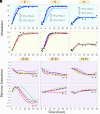Hypernetwork modeling and topology of high-order interactions for complex systems
- PMID: 39316048
- PMCID: PMC11459168
- DOI: 10.1073/pnas.2412220121
Hypernetwork modeling and topology of high-order interactions for complex systems
Abstract
Interactions among the underlying agents of a complex system are not only limited to dyads but can also occur in larger groups. Currently, no generic model has been developed to capture high-order interactions (HOI), which, along with pairwise interactions, portray a detailed landscape of complex systems. Here, we integrate evolutionary game theory and behavioral ecology into a unified statistical mechanics framework, allowing all agents (modeled as nodes) and their bidirectional, signed, and weighted interactions at various orders (modeled as links or hyperlinks) to be coded into hypernetworks. Such hypernetworks can distinguish between how pairwise interactions modulate a third agent (active HOI) and how the altered state of each agent in turn governs interactions between other agents (passive HOI). The simultaneous occurrence of active and passive HOI can drive complex systems to evolve at multiple time and space scales. We apply the model to reconstruct a hypernetwork of hexa-species microbial communities, and by dissecting the topological architecture of the hypernetwork using GLMY homology theory, we find distinct roles of pairwise interactions and HOI in shaping community behavior and dynamics. The statistical relevance of the hypernetwork model is validated using a series of in vitro mono-, co-, and tricultural experiments based on three bacterial species.
Keywords: ecological behavior; ecological community; evolutionary game theory; high-order interaction; pairwise interaction.
Conflict of interest statement
Competing interests statement:The authors declare no competing interest.
Figures







References
-
- Ratzke C., et al. , Strength of species interactions determines biodiversity and stability in microbial communities. Nat. Ecol. Evol. 4, 376–383 (2020). - PubMed
-
- Wuest S. E., et al. , Ecological and evolutionary approaches to improving crop variety mixtures. Nat. Ecol. Evol. 5, 1068–1077 (2021). - PubMed
MeSH terms
Grants and funding
LinkOut - more resources
Full Text Sources

